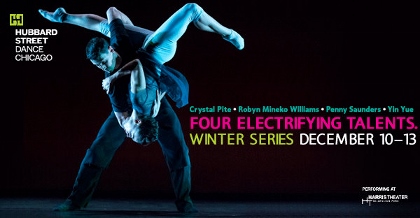LEAPING TO THE SOLSTICE
Between now and Sunday, four innovative female choreographers offer an evening of motion quests. The Harris Theatre is the backdrop for themes of not-so-close encounters contrasted with sometimes cloying connections. It makes sense: What can show the mutability of desire better than dance, where what might have been and what must have happened are separated by seconds? Hubbard Street Dance Chicago’s Season 38 Winter Series abounds in fractile fragments, literally letting go and breaking up. The sheer variety of these four works would be recommendation enough. But they persist in memory because of the beautiful obsessions the designers work out from moment to movement.
Opening the evening for the five young members of Hubbard Street 2 is a newly commissioned work by Chinese-American choreographer Yin Yue to a pulsating score by Gas, Machinefabriek, Michael Banabila, The Advent, and Jason Fernandez. “A Glimpse Inside a Shared Story” implies narrative cohesion but this is a dance of desperations.
Caught up in fluid but seemingly uncontrollable gyrations, the quintet twirl and whirl in captivating combinations that seem to plead for passion as much as evoke it. Whether synchronous in tense tandem or adhering to each other’s bodies as only youth can carry off, the tantalizing “glimpse” provided by these supple and effortlessly athletic performers suggest more than a “shared story”: Emotions in this frenetic and literally fast-paced world get invented, then eroded, with feet and arms moving faster than the audience’s collective eyes.
A 2014 Hubbard premiere, Robyn Mineko Williams’ “Waxing Moon,” shares elements of Yin Yue’s compulsive choreography. It depicts three interchanging dancers coming to terms with conflict.
Set to music by Chicago composers Robert F. Haynes and Tony Lazzara that alternates between lyrical adagio dances and a clambering percussive intensity, this moody work exposes Andrew Murdock and Jason Hortin as possible split-off sides of the same paramour, alternating in tender and traumatic combinations with Jacqueline Burnett’s hard-running lover. In the end the “moon,” it seems, gives way to a glowing sunrise that transforms the partners into silhouettes. If before they soared and swelled with the growing moon, now they calm down into the couple they were meant to inhabit.
A more communal work (for four interlocking couples), Penny Saunders’ “Out of Keeping” is a world premiere ripe with literal match-making by the color-coordinated artists. Performed between two screens to a diverse musical backdrop that ranges from modern (Hilary Hahn among others) to classical (Domenico Scarlatti), it features silent movement, rhapsodic couplings, and, from the women, a kind of angular anguish that may well be “out of keeping” with the usual reputable romance. Salutes, semaphore gestures and robotic “breakout” sections curiously combine as solo turns morph into kinetic duets.
A very fluid 2012 piece originated by Nederlands Dans Theater to a sensuous chamber-music score by Johannes Brahms, “Solo Echo” is Crystal Pite’s very original take on a serene poem “Lines for Winter” by Mark Strand. Here seven elaborately interconnected dancers/warriors in dark green khaki erupt in what I call “frieze-framed” tableaux, seemingly group statues or fragments from a Greek temple depicting the “agon” of battle. Recalling Army Rangers caught in the throes of combat, this unit constantly freezes in formation or full flight.
That’s how I saw it. But, as public as “Solo Echo” appears, Pite envisions it instead as “one man reckoning with himself at the end of his life.” Pite splits him seven ways: “He is portrayed through both male and female bodies, and through various physiques and strengths. Each performer is a distinct and nuanced version of the character, and the connections between them evoke a man coming to terms with himself.”
Well, yes, it does seem to be a “solo” search for continuity among change. Nonetheless it equally resembles the give and take of a band of brothers. That’s the beauty of this performing art: Dance can’t really disguise itself. Everything it does it is. It can’t help but become itself, whatever tale or theme it seeks to convey. What you see seems a small part of what you get.
photos by Todd Rosenberg
Hubbard Street Dance Chicago
Season 38 Winter Series
Harris Theater for Music and Dance
Millennium Park, 205 East Randolph St
ends on December 13, 2015
for tickets, call 312-850-9744 or visit Hubbard Street Dance
for info on Chicago Theater, visit Theatre in Chicago










